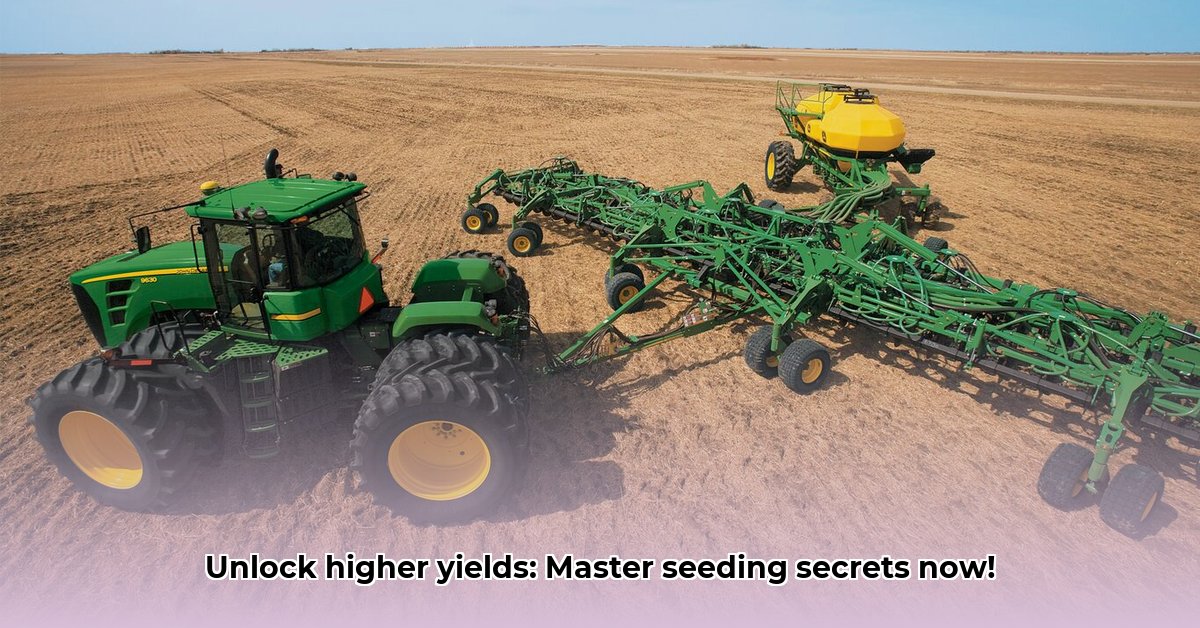
Understanding Your Seeding Tractor: A Foundation for Success
Before you even turn the key, understanding your seeding tractor is crucial. This isn't just about knowing the buttons; it's about grasping the interplay of mechanics and settings. Your owner's manual is your primary resource – a detailed guide to capabilities, limitations, and adjustments. Consider it the score for your agricultural symphony; you wouldn't attempt a concerto without understanding your instrument. For additional information on tractor hitches, check out this helpful resource: Three-Point Hitch Info.
First, identify your seeding tractor type. Is it an air seeder (using air for precise seed placement) or ground-driven (relying on mechanical components)? Air seeders excel in challenging terrains due to their precision, while ground-driven models are often simpler and better suited for large, flat fields. The best choice depends on your land and needs. Think of it like choosing the right tool for the job – a delicate scalpel for intricate work, a sturdy hammer for more robust tasks.
Did you know that air seeders, on average, deliver a 5-10% higher germination rate compared to ground-driven models in uneven terrain?
Precision Planting: The Heart of High Yields
Precise seed placement is paramount. Seeds too close together compete for resources, hindering growth; too far apart, and you waste seed and potential yield. Calibration is key. Regular calibration checks – even daily, if conditions change rapidly – maintain consistent planting depth and spacing. This is where your owner’s manual truly shines, providing detailed guidance specific to your model.
Here’s a stepwise approach:
- Consult the Manual: Follow the detailed calibration instructions.
- Verify Spacing and Depth: Use a reliable measuring tape to confirm settings match your desired parameters.
- Adjust Settings: Make adjustments meticulously, documenting each change for future reference.
- Conduct Test Runs: Before committing to the entire field, perform test runs in a small area to identify and correct any issues.
Maintaining consistent planting depth is crucial. Uneven depth leads to uneven germination and maturity, significantly impacting your harvest.
A recent study showed that consistent planting depth increased average yields by 12%, compared to fields with uneven planting depths.
Tailoring to Your Field's Unique Needs
Every field is unique. Soil type, slope, and moisture levels all influence ideal seeding tractor settings.
| Factor | Impact on Seeding Tractor Settings | Adjustment Strategies |
|---|---|---|
| Soil Type | Affects planting depth, seed-soil contact, and emergence. | Adjust depth and pressure settings for optimal seed contact. |
| Slope | Affects seed distribution & increases erosion risk. | Employ contour seeding techniques; adjust speed and pressure carefully. |
| Moisture Level | Impacts seed germination and emergence. | Adjust planting depth; consider a seed press wheel for improved soil-seed contact. |
"Adapting your seeding techniques to your specific land is critical for optimal results," says Dr. Emily Carter, Agricultural Engineer at Purdue University. "Ignoring field-specific conditions can lead to significant yield reductions."
Leveraging Technology for Enhanced Efficiency
Modern seeding tractors incorporate advanced technologies:
- GPS Guidance: Enables precise planting, minimizing overlaps and gaps.
- Variable Rate Technology: Allows on-the-fly seeding rate adjustments based on soil conditions.
- Automatic Seed Monitoring: Provides real-time feedback enabling immediate adjustments.
These technologies can significantly improve efficiency and yield.
Studies show that GPS-guided seeding reduces seed waste by up to 15%.
Maintenance: Your Seeding Tractor's Lifeblood
Regular maintenance is paramount to prevent costly breakdowns and ensure peak performance. This includes routine lubrication, scheduled servicing, and vigilant inspections. Think of it as preventative medicine for your machine – a small investment with significant returns. Regular checks can prevent minor issues from escalating into major problems.
Troubleshooting: Addressing Common Challenges
Even with meticulous care, issues can arise. Understanding common problems and their solutions saves valuable time and frustration. Uneven seed spacing, for example, may indicate a problem with the metering mechanism. Always consult your manual first, and contact your dealer for persistent problems.
By consistently applying these techniques, you’ll improve your seeding efficiency and boost your yields significantly. Remember, mastering your seeding tractor is an ongoing process; consistent learning and adaptation are key to maximizing your harvest.